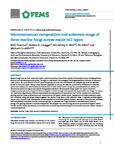Macromolecular composition and substrate range of three marine fungi across major cell types
| dc.contributor.author | Thomas, S | |
| dc.contributor.author | Lengger, SK | |
| dc.contributor.author | Bird, KE | |
| dc.contributor.author | Allen, R | |
| dc.contributor.author | Cunliffe, Michael | |
| dc.date.accessioned | 2022-03-04T10:30:32Z | |
| dc.date.available | 2022-03-04T10:30:32Z | |
| dc.date.issued | 2022-01-24 | |
| dc.identifier.issn | 2633-6685 | |
| dc.identifier.issn | 2633-6685 | |
| dc.identifier.uri | http://hdl.handle.net/10026.1/18883 | |
| dc.description.abstract |
<jats:title>Abstract</jats:title> <jats:p>Marine fungi exist as three major cell types: unicellular yeasts, filamentous hyphae and zoosporic early-diverging forms, such as the Chytridiomycota (chytrids). To begin to understand the ecological and biogeochemical influence of these cell types within the wider context of other plankton groups, cell size and macromolecular composition must be assessed across all three cell types. Using a mass–balance approach to culture, we describe quantitative differences in substrate uptake and subsequent macromolecular distribution in three model marine fungi: the yeast Metschnikowia zobellii, the filamentous Epicoccum nigrum and chytrid Rhizophydium littoreum. We compared these model cell types with select oleaginous phytoplankton of specific biotechnological interest through metanalysis. We hypothesise that fungal cell types will maintain a significantly different macromolecular composition to one another and further represent an alternative grazing material to bacterioplankton and phytoplankton for higher trophic levels. Assessment of carbon substrate range and utilisation using phenotype arrays suggests that marine fungi have a wide substrate range. Fungi also process organic matter to an elevated-lipid macromolecular composition with reduced-protein content. Because of their size and increased lipid composition compared to other plankton groups, we propose that fungi represent a compositionally distinct, energy-rich grazing resource in marine ecosystems. We propose that marine fungi could act as vectors of organic matter transfer across trophic boundaries, and supplement our existing understanding of the microbial loop and carbon transfer in marine ecosystems.</jats:p> | |
| dc.format.extent | xtab019- | |
| dc.format.medium | Electronic-eCollection | |
| dc.language | en | |
| dc.language.iso | en | |
| dc.publisher | Oxford University Press (OUP) | |
| dc.subject | allometry | |
| dc.subject | carbohydrate | |
| dc.subject | lipid | |
| dc.subject | marine fungi | |
| dc.subject | protein | |
| dc.title | Macromolecular composition and substrate range of three marine fungi across major cell types | |
| dc.type | journal-article | |
| dc.type | Journal Article | |
| plymouth.author-url | https://www.ncbi.nlm.nih.gov/pubmed/37332499 | |
| plymouth.volume | 3 | |
| plymouth.publication-status | Published | |
| plymouth.journal | FEMS Microbes | |
| dc.identifier.doi | 10.1093/femsmc/xtab019 | |
| plymouth.organisational-group | /Plymouth | |
| plymouth.organisational-group | /Plymouth/Faculty of Science and Engineering | |
| plymouth.organisational-group | /Plymouth/Faculty of Science and Engineering/School of Biological and Marine Sciences | |
| plymouth.organisational-group | /Plymouth/REF 2021 Researchers by UoA | |
| plymouth.organisational-group | /Plymouth/REF 2021 Researchers by UoA/UoA07 Earth Systems and Environmental Sciences | |
| plymouth.organisational-group | /Plymouth/Users by role | |
| plymouth.organisational-group | /Plymouth/Users by role/Academics | |
| dc.publisher.place | England | |
| dcterms.dateAccepted | 2021-11-25 | |
| dc.rights.embargodate | 2022-3-5 | |
| dc.identifier.eissn | 2633-6685 | |
| dc.rights.embargoperiod | Not known | |
| rioxxterms.versionofrecord | 10.1093/femsmc/xtab019 | |
| rioxxterms.licenseref.uri | http://www.rioxx.net/licenses/all-rights-reserved | |
| rioxxterms.licenseref.startdate | 2022-01-24 | |
| rioxxterms.type | Journal Article/Review |


